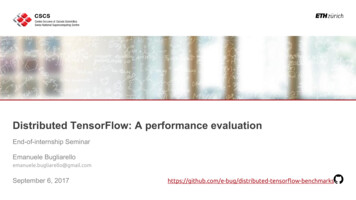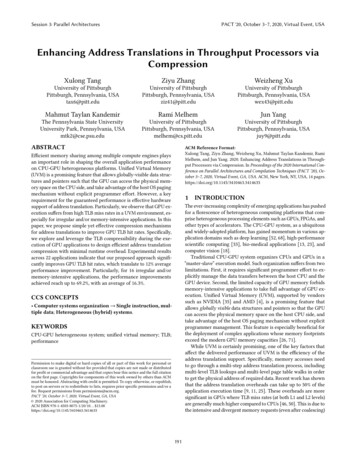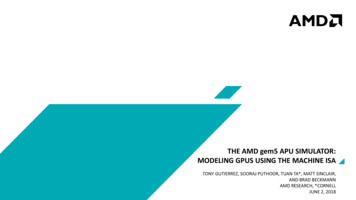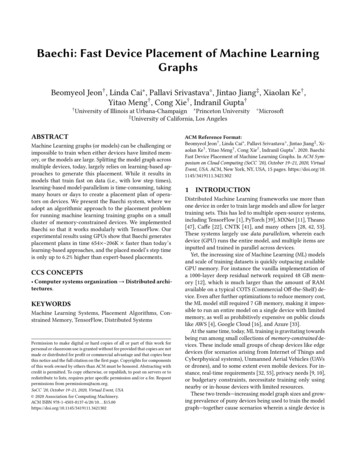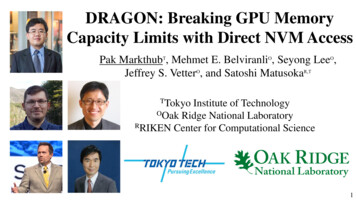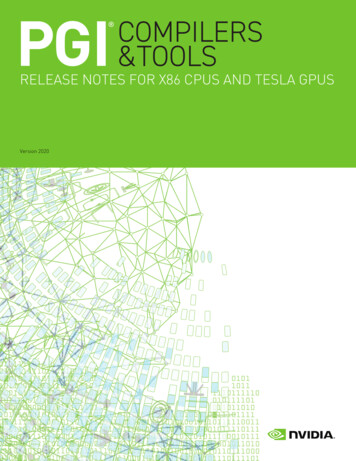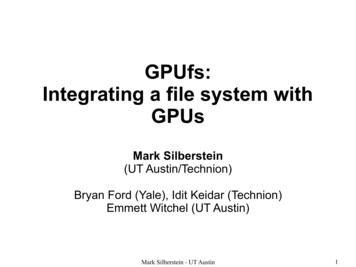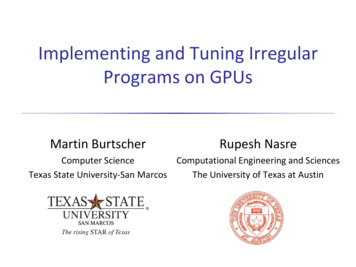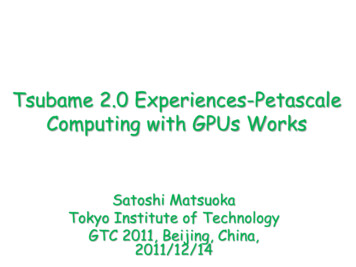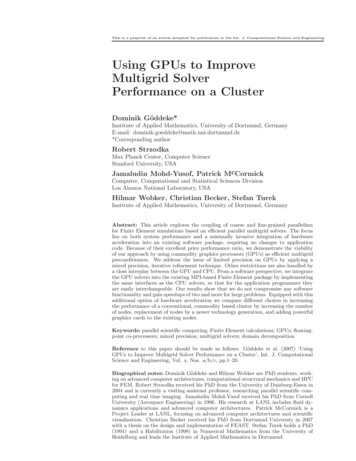
Transcription
This is a preprint of an article accepted for publication in the Int. J. Computational Science and EngineeringUsing GPUs to ImproveMultigrid SolverPerformance on a ClusterDominik Göddeke*Institute of Applied Mathematics, University of Dortmund, GermanyE-mail: g authorRobert StrzodkaMax Planck Center, Computer ScienceStanford University, USAJamaludin Mohd-Yusof, Patrick McCormickComputer, Computational and Statistical Sciences DivisionLos Alamos National Laboratory, USAHilmar Wobker, Christian Becker, Stefan TurekInstitute of Applied Mathematics, University of Dortmund, GermanyAbstract: This article explores the coupling of coarse and fine-grained parallelismfor Finite Element simulations based on efficient parallel multigrid solvers. The focuslies on both system performance and a minimally invasive integration of hardwareacceleration into an existing software package, requiring no changes to applicationcode. Because of their excellent price performance ratio, we demonstrate the viabilityof our approach by using commodity graphics processors (GPUs) as efficient multigridpreconditioners. We address the issue of limited precision on GPUs by applying amixed precision, iterative refinement technique. Other restrictions are also handled bya close interplay between the GPU and CPU. From a software perspective, we integratethe GPU solvers into the existing MPI-based Finite Element package by implementingthe same interfaces as the CPU solvers, so that for the application programmer theyare easily interchangeable. Our results show that we do not compromise any softwarefunctionality and gain speedups of two and more for large problems. Equipped with thisadditional option of hardware acceleration we compare different choices in increasingthe performance of a conventional, commodity based cluster by increasing the numberof nodes, replacement of nodes by a newer technology generation, and adding powerfulgraphics cards to the existing nodes.Keywords: parallel scientific computing; Finite Element calculations; GPUs; floatingpoint co-processors; mixed precision; multigrid solvers; domain decompositionReference to this paper should be made as follows: Göddeke et al. (2007) ‘UsingGPUs to Improve Multigrid Solver Performance on a Cluster’, Int. J. ComputationalScience and Engineering, Vol. x, Nos. a/b/c, pp.1–20.Biographical notes: Dominik Göddeke and Hilmar Wobker are PhD students, working on advanced computer architectures, computational structural mechanics and HPCfor FEM. Robert Strzodka received his PhD from the University of Duisburg-Essen in2004 and is currently a visiting assistant professor, researching parallel scientific computing and real time imaging. Jamaludin Mohd-Yusof received his PhD from CornellUniversity (Aerospace Engineering) in 1996. His research at LANL includes fluid dynamics applications and advanced computer architectures. Patrick McCormick is aProject Leader at LANL, focusing on advanced computer architectures and scientificvisualization. Christian Becker received his PhD from Dortmund University in 2007with a thesis on the design and implementation of FEAST. Stefan Turek holds a PhD(1991) and a Habilitation (1998) in Numerical Mathematics from the University ofHeidelberg and leads the Institute of Applied Mathematics in Dortmund.
1INTRODUCTIONproblem lies in the performance/cost ratio. While there exist computing devices better suited to address the memorywall problem, they are typically more expensive to purchase and operate. This is due to small production lots,immature or complex software tools, and few experiencedprogrammers. In addition there is always the question ofcompatibility and the risk of having invested into a discontinued technology, both of which would lead to higheroverall costs. On the other hand, standard components arecheaper, readily available, well tested, modular, easier tooperate, largely compatible, and they commonly supportfull development tool chains. In the end, these characteristics tend to favor economic considerations over memoryand computational efficiency.However, if one standard component is easy to operateand maintain, this does not imply that a large number ofthem is just as easy to handle. Nevertheless, an analysisof the recent TOP500 lists [46] reveals a quickly growingnumber of clusters assembled from commodity hardwarecomponents listed among more traditional HPC systems.Commodity Central Processing Units (CPUs) have madethe transition from the field of latency dominated officeapplications, to the realm of throughput dominated HPCprograms. This trend has been partially driven by theperformance demands of consumer level multimedia applications. Even with these advancements, commodity processors still suffer from the memory wall problem.The industry is currently experiencing the beginning ofa similar transition of other hardware to the field of HPC,but this time sustained by the mass market of computergaming. Graphics Processing Units (GPUs) and more recently the Cell [50, 68] and the PhysX [1] processors targetthis performance hungry entertainment community. In thiscase, we once again have a situation in which hardware hasbeen developed for an application domain that has verylimited relevance to HPC. But similar to today’s commodity CPUs, these devices have advanced to the point thattheir performance/cost ratio makes them of interest to thehigh-performance community.A similar development occurs in the market of Field Programmable Gate Arrays (FPGAs). Initially designed asgeneral integrated circuit simulators, current devices havediversified into different types optimized for specific applications areas. Again HPC is not their main market, butsome of the specializations target similar processing requirements. Cray’s XD1 system is an example of a supercomputer designed to leverage the power of FPGAs [11].Repeatedly adapting different architectures, especiallythose designed for other application domains, to the needsof HPC is clearly not an ideal situation. However, the current high-performance market is not large enough to makethe enormous costs associated with new hardware designand the supporting development environment profitable.While some companies offer accelerator boards for HPC,for example Clearspeed [8], they are typically also suitablefor the needs of other application domains. This leads usin an interesting direction, where we no longer try to runeverything on the same kind of processor, but rather pickThe last several years have seen a resurgence of interestin the use of co-processors for scientific computing. Several vendors now offer specialized accelerators that provide high-performance for specific problem domains. Inthe case of a diverse High Performance Computing (HPC)environment, we would like to select one or more of thesearchitectures, and then schedule and execute portions ofour applications on the most suitable device. In practicethis is extremely difficult because these architectures oftenhave different restrictions, the time required to move databetween the main processor and the co-processor can dominate the overall computation time, and programming in aheterogeneous environment is very demanding. In this paper we explore this task by modifying an existing parallelFinite Element package, with more than one hundred thousand lines of Fortran code, to leverage the power of specialized co-processors. Instead of exclusively focusing onperformance gains, we also concentrate on a minimally invasive integration into the original source code. Althoughthe coupling of coarse and fine-grained parallelism is stilldemanding, we can restrict the code changes in the original package toapproximately 1000 lines (Section 4.4), retain all previous functionality of the package (Section 5.3), give the benefit of hardware acceleration to unchangedapplication code based on the package (Section 4), and multiply the performance of the multigrid solvers bya factor of two to three (Section 5).In this section we discuss the interaction of the hardware, software and economic considerations, and providethe necessary background. Section 2 continues with the description of the test scenario and the involved system components. The specific details of the underlying Finite Element package are outlined in Section 3. Section 4 considersthe algorithmic approach and implementation details. Results are discussed in Section 5. Finally, we present ourconclusions and plans for future work in Section 6.1.1Hardware for HPCThe vast majority of processor architectures are both fastand energy efficient when the required data is locatedwithin the processor’s local memory. In contrast, thetransport of data between system and processor memory isexpensive both in terms of time and power consumption.This applies to both the small scales in a processor, as wellas at the larger system level.Even though this memory wall problem [67] has beenknown for many years, the common choice of processorsand systems in HPC often seems to ignore this fact. TheCopyright c 200x Inderscience Enterprises Ltd.2
from among numerous devices those that are best suitedfor the different parts of our application. This introducesa new imbalance between the theoretical efficiency of thegiven hardware-software combination and the achievableefficiency, which is likely to degrade with higher numbersof heterogeneous components.1.2Because the co-processors are optimized for different application areas than HPC, we must respect certain restrictions and requirements in the data processing to gain performance. But this does not mean that we are willingto sacrifice any software functionality. In particular, wemake absolutely no compromises in the final accuracy ofthe result. The hardware restrictions are dealt with bythe software which drives the co-processor and where theco-processor is incapable or unsuitable for executing somepart of the solver, it falls back to the existing CPU implementation. It is important to note that we are not tryingto make everything run faster on the co-processor. Insteadeach architecture is assigned those tasks that it executesbest. The application never has to deal with these decisions, as it sees an accelerated solver with exactly thesame interface as the pure CPU version. One assumptionwe make here is that the tasks to be performed are largeenough, so that the costs of configuring the co-processor,and moving data back and forth between CPU and coprocessor, can be amortized over the reduced runtime.In view of the memory wall problem we are convincedthat despite the different structures of the co-processors,the computation can be arranged efficiently as long as datatransport between host and co-processor is minimized andperformed in coherent block transfers that are ideally interleaved with the computation. Therefore, the structurepreserving data storage and handling is the main assumption we make about the FE package to enable the couplingof the coarse and fine grained parallelism. All other conditions of the existing software packages are kept to a minimum. By taking this approach, the data structure basedcoupling can be applied to many parallel applications andexecuted on different parallel co-processors.Despite the different internal structure of the parallel coprocessors, they share enough similarities on the data flowlevel to allow for a similar interface to the CPU. Clearly,the device specific solver must be reimplemented and tunedfor each architecture, but this requires only the code for alocal one node solution, as the coarse grained parallelism istaken care of by the underlying FE package on the CPUs.Due to economic considerations, a CPU-GPU coupling ineach node of a cluster is our first choice for a heterogeneouscomputing platform. We focus on this hardware combination throughout the remainder of the paper.Software for HPCIn general, the reluctance to complicate application software has been so high that promises of using heterogeneous architectures for significant speedups have met limited success. However, the move towards parallel computing has also reached the CPU arena, while the performance gap of the CPU to parallel co-processors has further widened. Moreover, computing with dedicated coprocessors not only increases performance but also addresses the memory wall, the power problem, and can alsoreduce other indirect costs associated with the size of clusters because fewer nodes would be required. The successof a particular co-processor depends heavily on the software complexity associated with the resulting heterogeneous system.Therefore, our main focus is the minimally invasive integration of the fine-grained parallelism of the co-processorwithin the coarse-grained parallelism of a Finite Element(FE) package executing on clusters. Our goal is to integrate the hardware alternatives at the cluster node level.The global domain decomposition method does not distinguish between different architectures but rather betweendifferent solvers for the sub-domains. The CPU is the mostgeneral architecture and supports all types of solvers andgrids. The dedicated co-processors offer accelerated backends for certain problem structures, that can be chosen automatically if applicable. The application never has to dealwith the different computing and programming paradigms.Most importantly, the interface to the FE package remainsthe same as in the unaccelerated version.For this abstraction to work, the initial FE package mustfulfill certain criteria. Grid generation for complex simulation domains is a demanding task. While some areascan be easily covered with a regular grid, others may require an unstructured or even adaptive discretization toaccurately capture the shape without wasting too manyelements. It is important that the FE package maintainsthe distinction between structured and unstructured partsof the discretization, rather than trying to put everythinginto a homogeneous data structure, because the parallelco-processors can utilize much more efficient solvers whenprovided with the additional information about the gridstructure. In fact, not only the co-processors benefit fromthis additional information, the sub-problems with a regular structure also execute much faster on the CPU becauseof coherent memory access patterns. However, for the CPUthis is merely an additional advantage in processing of thedata structures, whereas the parallel co-processors dependheavily on certain data movement patterns and we loseseveral factors in speedup if we ignore them.1.3GPU backgroundWe aim at efficient interoperability of the CPU and GPUfor HPC in terms of both computational and user efficiency, i.e. the user should be able to use the hardwareaccelerated solvers with exactly the same ease as their software equivalents. In our system, this is achieved by a simple change in parameter files. We assume that both anMPI-based FE package and a (serial) GPU-based multigrid solver are given. While most readers will be familiar with the ideas and concepts of the former, the sameis probably less true for the latter. Since we believe thesame concept can be applied to other co-processors, we3
do not use any GPU specific terminology to explain theinterfaces. However, the understanding of the data transport and computation on the GPU in balance with theCPU (discussed in Section 4) requires some insight intothe computing paradigm on the GPU.For an algorithmic CPU-GPU comparison without anygraphics terminology we refer to Strzodka et al. [59]. Detailed introductions on the use of GPUs for scientific computing with OpenGL and high level graphics languages(GPGPU – general purpose computation on GPUs) canbe found in several book chapters [30, 52]. For tutorialcode see Göddeke [23]. The survey article by Owens etal. [48] offers a wider view on different general purpose applications on the GPU; and the community web site has alarge collection of papers, conference courses and furtherresources [27].Our implementation of linear algebra operators and inparticular multigrid solvers on GPUs builds upon previousexperience in the GPGPU community. Most relevant toour work are implementations of multigrid solvers on GPUsstudied by Bolz et al., Krüger and Westermann, Goodnightet al., Strzodka et al. [5, 25, 42, 60] and the use of multipleGPUs for discrete computations by Fan et al., Fung andMann, and Govindaraju et al. [19, 20, 26]. However, thesepublications do not focus on the achievable accuracy.We discuss implementational aspects in Section 4.4.1.4tle bit of relative accuracy with a low precision solver andaccumulate these gains in high precision. While originallythis technique had been used to increase the accuracy of acomputed solution, it has recently regained interest withrespect to the potential performance benefits. Langou etal. evaluate mixed precision schemes for dense matrices inthe LAPACK context on a wide range of modern CPUsand the Cell processor [43]. The viability of mixed precision techniques on GPUs for (iterative) multigrid solverson strongly anisotropic grids and thus matrices with highcondition numbers is demonstrated by Göddeke et al. [24].Both publications emphasize that the achievable accuracyin the results remains identical to computation in high precision alone. Without the mixed precision approach wewould need to emulate double precision operations on theparallel devices, thus doubling the required bandwidth andincrease the operation count by at least a factor of ten.The GPU solvers only contribute a small step forwardtowards the overall solution, and our hope is that the approach is reasonably stable in view of possible false readsor writes into memory. Graphics cards do not utilize ErrorCorrecting Code (ECC) memory, which is one of the remaining issues for their adoption in HPC applications (theother one being the lack of double precision storage andarithmetic, see previous paragraph). By avoiding lengthycomputations on the processor our hope is to reduce theprobability of memory errors and transient faults being introduced into the calculations. Additionally, our proposedhierarchical solver (see Section 3.2) corrects single-eventerrors in the next iteration. To date we have not seen evidence of such memory errors affecting our results. For adetailed discussion and analysis of architectural vulnerability for GPUs in scientific computing, as well as someproposals for extending graphics hardware to better support reliable computation, see Sheaffer et al. [55].Low precisionAn important drawback shared by several of the coprocessors is the restriction to single floating-point representation. For instance, GPUs implement only quasi IEEE754 conformal 32-bit floating point operations in hardware, without denormalization and only round-to-zero.For many scientific computations this is actually an efficiency advantage as the area required for a multipliergrows quadratically with the operand size. Thus if thehardware spends the area on single precision multipliers,it offers four times as many of them as double multipliers. For floating-point dominated designs this has a hugeimpact on the overall area, for cache and logic dominateddesigns the effects are much smaller, but we ideally wantmany parallel floating-point units (FPUs). In FPGAs, thisbenefit is truly quadratic, whereas in the SIMD units ofCPUs, the savings are usually reduced to linear becauseof the use of dual-mode FPUs that can compute in single and double precision. In addition to more computational resources, the use of single precision also alleviatesthe memory wall problem. For a more thorough discussionof the hardware efficiency of low precision components seeGöddeke et al. [24].Clearly, most numerical applications require high precision to deliver highly accurate (or even correct) results.The key observation is that high precision is only necessaryin a few, crucial stages of the solution procedure to achievethe same result accuracy. The resulting technique of mixedprecision iterative refinement has already been introducedin the 1960s [45]. The basic idea is to repeatedly gain a lit-1.5CPU-GPU couplingIf the Finite Element package manages a combination ofstructured and unstructured sub-problems as explained inSection 1.2, then we want to execute GPU-acceleratedsolvers for the structured sub-problems. In the contextof a (parallel) multigrid solver, this assigns the GPU thetask of a local smoother.For an efficient coupling between the FE package and theGPU solvers, we need to integrate decisions about how todistribute the sub-problems onto the different computational resources. The first choice is simply based on theavailability of solvers. The GPU backend (currently) supports only a small subset of the CPU solvers, in particularsome sub-problems converge only with an advanced solverwhich is available only on the CPU. The second choice ismore complex and involves the assignment to an architecture based on the type and size of the sub-problem. Twoadditional factors further complicate the decision process.First, the GPU solver is in fact always a coupled GPU-CPUsolver as it requires some CPU support to orchestrate thecomputation on the GPU, to obtain the double precision4
is justified by the observation that in real-world simulations Poisson problems are often the most time-consumingsubtasks. For instance, the solution of the Navier-Stokesequations in Computational Fluid Dynamics (CFD) using projection schemes requires the accurate solution of aPressure-Poisson problem in every time-step [64].In our tests, we discretize several two-dimensional domains using conforming bilinear Finite Elements of the Q1FEM space. We choose analytic test functions u0 and define the right hand side as the analytical Laplacian of thesefunctions: f u0 . Thus we know that u0 is the exact analytical solution to the continuous PDE, and we canevaluate the integral L2 error of the discretely computedresults against the analytical reference solution u0 to measure the accuracy.In the evaluation of this test scenario we are mainly interested in accuracy, absolute performance and weak scalability. See Section 5 for results.accuracy with iterative refinement, to calculate local contributions to global vectors and to perform the MPI communication with the other processes (we discuss this inmore detail in Section 4). Second, due to the memory wallproblem, the computation on a principally slower architecture might be faster if less data has to be moved. Thismeans that the ratios between the computational powerand memory bandwidth, techniques to bypass the CPU inmemory transfers to the GPU and to overlap computationwith data transport are crucial.Overall we have a complicated dynamic scheduling problem which requires a thorough examination, and we do notaddress it in this paper. For the presented examples weuse a simple static or semi-automatic heuristic schedulingbased on experience and serial calibration runs.1.6Related workMore elaborate discussions on hardware and softwaretrends in HPC for PDEs are presented by Rüde, Keyes,Hoßfeld, Gropp et al. and Colella et al. [9, 28, 34, 37, 51].Hardware considerations for large-scale computing areelaborated upon by DeHon, Khailany et al., and Dally etal. [12, 14, 38]. General trends and challenges to furtheruphold Moore’s Law are discussed in detail in the annualSEMATECH report [54].Data locality techniques, especially for multigrid methods, have been extensively studied by Douglas, Rüde et al.and Turek et al. [16, 17, 41, 65]. Optimization techniquesfor HPC are presented by Garg and Sharapov, and Whaleyet al. [21, 66].Surveys of different parallel computing architectures, especially reconfigurable systems, can be found in Hartenstein, Bondalapati and Prasanna, and Compton andHauck [6, 10, 32, 33]. Exploitation of different types ofparallelism and their relevance are performed by Sankaralingam et al., Guo et al., Taylor et al. [29, 53, 62]. Comparisons of multiple parallel architectures on typical streamkernels and PDE solvers are studied by Suh et al. andStrzodka [58, 61].Iterative refinement methods are discussed in length byDemmel et al., and Zielke and Drygalla [15, 70]. Applications on the CPU usually focus on efficient extensions ofthe precision (in intermediate computations) beyond thedouble precision format as demonstrated by Li et al., andGeddes and Zheng [22, 44]. GPUs and FPGAs and moreliterature in the context of emulated- and mixed-precisioncomputations are discussed by Göddeke et al. [24].Related work on the use of GPUs as co-processors ispresented in Section 1.3.22.12.2HardwareFor the solution of the Poisson problem we use up to 17nodes of two different clusters DQ and LiDO using variousconfigurations. The DQ cluster nodes contain dual EM64TCPUs, a single PCI Express (PCIe) connected graphicscard, and an InfiniBand interface that is connected to afull bandwidth switch. The detailed configuration for eachnode is:CPU: Dual Intel EM64T, 3.4 GHz, 1 MiB L2 cache,800 MHz FSB, 600 W power supply.RAM: 8 GiB1 (5.5 GiB available), 6.4 GB/sshared bandwidth (theoretical).POWER: 315 W average power consumptionunder full load without the GPU.GPU: NVIDIA Quadro FX4500 PCIe, 430 MHz,114 W max power.RAM: 512 MiB, 33.6 GB/s bandwidth.POWER: 95 W average power consumptionunder full load of the GPU alone.It costs approximately 1, 400 to add the FX4500 graphics card to the system. In comparison, a new cluster nodewith an identical configuration, but without a GPU, costsapproximately 4, 000, not counting infrastructure such asrack space and free ports of the switches. No additionalpower supply or cooling unit is required to support thegraphics cards in the cluster. Moreover, the cluster hasbeen reliable with the addition of graphics cards that haverequired only a small amount of additional administrationand maintenance tasks. Equivalent consumer-level graphics cards cost approximately 500.The chipset used in DQ’s EM64T architecture presentsa significant performance bottleneck related to a sharedmemory bus between the two processors. The LiDO clusterSYSTEM COMPONENTSTest scenarioTo evaluate the GPU accelerated solver we focus on thePoisson problem u f on some domain Ω R2 , which1 International5standard [35]: G 109 , Gi 230 , similarly Mi, Ki.
does not have this limitation and allows us to quantify the 3 DATA STRUCTURE AND TRAVERSALresulting benefits of the higher bandwidth to main memory. Each node of LiDO is connected to a full bandwidth 3.1 Structured and unstructured gridsInfiniBand switch and is configured as follows:CPU: Dual AMD Opteron DP 250, 2.4 GHz, 1 MiBL2 cache, 420 W power supply.RAM: 8 GiB (7.5 GiB available), 5.96 GB/s peakbandwidth per processor.POWER: 350 W average power consumptionunder full load.A new cluster node with an identical configuration costsapproximately 3, 800. Unfortunately, this cluster does notcontain graphics hardware, therefore, we cannot test allpossible hardware configurations. But the importance ofthe overall system bandwidth becomes clear from the results presented in Section 5.2.3Figure 1: An unstructured coarse grid composed generalized tensor-product macros with isotropic (regular) andanisotropic refinement.SoftwareWe use the Finite Element package Feast [3, 4, 65] as astarting point for our implementation. Feast discretizesthe computational domain into a collection of macros. Thisdecomposition forms an unstructured coarse grid of quadrilaterals, and each macro is then refined independently intogeneralized tensor-product grids, see Figure 1. On the resulting computational grid, a multilevel domain decomposition method is employed with compute intensive localpreconditioners. This is highly suitable for the parallelco-processors, as there is a substantial amount of localwork on each node to be done, without any communications interrupting the inner solver. In addition, new localsmoothers can be developed and tested faster on a singlemachine because they are never involved in any MPI calls.Feast provides a wide selection of smoothers forthe parallel multigrid solver, e.g. simple Jacobi iteration for almost isotropic sub-grids or operators, and ILUor alternating-directions tri-diagonal Gauss-Seidel (ADITRIGS) for more anisotropic cases. Thus, the solver foreach macro can be chosen to optimize the time to convergence. However, this matching of solvers and macrosis a fairly recent feature in Feast. Currently, two different local solvers can be used concurrently: CPU-basedcomponents take advantage of the collection of solversreadily available in Feast and are applied to local subproblems that require strong smoothing due to high degrees of anisotropy in the discretization. Our GPU-basedmultigrid solver currently only offers Jacobi smoothing andis applied to mostly isotropic sub-problems. Implementingstronger smoothers on the GPU in the future will allowus to tackle harder problems with fine grained parallelism.The next section motivates and explains in more detailFeast’s approach to domain discretization and the hierarchical solution.We use the GotoBLAS and UMFPACK [13] librariesin parts of the CPU implementation, and NVIDIA’s Cglanguage with OpenGL for the GPU code.Unstructured grids give unlimited freedom to place gridnodes and connect them to elements, but this comes ata high cost. Instead of conveying the data structure tothe hardware, we let the processor speculate about the arrangement by prefetching data that might be needed inthe future. Obviously, execution can proceed much fasterif the processor concentrates on the computation itself andknows ahead of time which data needs to be processed. Byavoiding memory indirections the bandwidth is utilized optimally, prefetching only the required data and maximizingthe reuse of data in smaller, higher level caches.From an accuracy point of view, the absolute freedomof unstru
Multigrid Solver Performance on a Cluster Dominik G oddeke* Institute of Applied Mathematics, University of Dortmund, Germany E-mail: dominik.goeddeke@math.uni-dortmund.de *Corresponding author Robert Strzodka Max Planck Center, Computer Science Stanford University, USA Jamaludin Mohd-Yusof, Patrick McCormick
